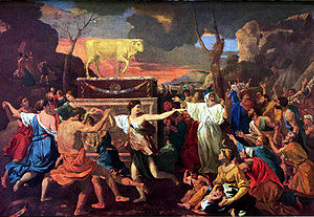At this point in the story, of course, the Israelites had just heard (from the very voice of God, no less) Commandment Number Two: "You shall not have any other gods before Me. You shall not make any sculpted image of what is in heaven above... You shall not prostrate before them or worship them, for I, Adonai, am your God..." (Exodus 20:3-5). Talk about bad timing...
The Golden Calf is the central image in the Jewish imagination of idolatry and the way that our dark side can separate us from God. Yet, the Golden Calf pops up in some very unexpected places in Jewish tradition. In the very places of the highest sanctity, we sometimes see reminders of the Golden Calf.
The first hint of this comes right in the story of the Golden Calf itself. In two swift verses, this week's parashah describes how Moses responded to the Golden Calf:
As soon as Moses came near the camp and saw the calf and the dancing, he became enraged; and he hurled the tablets from his hands and shattered them at the foot of the mountain. He took the calf that they had made and burned it; he ground it to powder and strewed it upon the water and so made the Israelites drink it (Exodus 32:19-20, JPS translation).
Now, why would Moses force the Israelites to drink the idol they had made? While dramatic, it seems odd. Was Moses trying to prove to the Israelites that the idol was not a god but just a thing? Perhaps. (But, you know, there are some religions in which people do ingest what they imagine to be the body of their god...) Maybe, Moses wanted to remind the Israelites that, even after the Golden Calf was destroyed, it continued to live on, within their very God-given bodies.
Many traditional commentators have noted that the story of the Golden Calf appears in an unlikely place within the narrative of the Torah. Parashat Ki Tisa follows two weeks of Torah readings that describe the design of the Mishkan (the portable tabernacle used by the Israelites to worship God in the wilderness) and the ritual objects used in it. Ki Tisa is followed by two more Torah portions that describe the actual construction of the Mishkan. Why is the Golden Calf standing, figuratively, right in the middle of the Mishkan, God's holy dwelling place?
As if this were not enough, there is another symbol of the Golden Calf sitting in the middle of one of Judaism's holiest objects. By tradition, the box of the tefillin worn on the head (bayit shel rosh) contains four scrolls that are rolled and tied with the hair of a calf's tail. One end of this little strand of hair passes through the bayit so that it is visible from the outside. According to the Zohar , this strand of hair is a representation of the Golden Calf (Zohar II 237b; with thanks to my teacher, Melila Hellner-Eshed, for pointing this out). We place the Golden Calf as a symbol between our eyes, in the midst of words of Torah and outwardly for the world to see. Why should that be?
The Golden Calf is a reminder of the darkness that lies within us. Rather than reject and deny the part of us that keeps us distant from God, Judaism keeps it right in front of our eyes where we can see it. It is the darkness from which holiness is able to emerge. Without the Golden Calf, it seems, we would not be able to recognize or realize holiness. That is why it is sitting there, right in the middle of the Mishkan, right between our eyes.
And here is a simple truth: You cannot be happy while you are cutting off your limbs. We do not prostrate ourselves or worship the Golden Calf, but we do acknowledge it and accept that it is part of who we are. We are called upon to live joyfully in the peace of knowing that we are made with conflicting instincts and inclinations. There is no shame in having a dark side, dark feelings, and dark instincts—indeed, it is the thing that enables the light to emerge from our souls. That should be a source of joy, not guilt.
Judaism is not a religion for those who profess themselves to be all-pure, all-knowing, or infallible—which is really just a denial of our nature of light and darkness. There is something very close to the heart of Judaism that rankles against the certainty of fundamentalism. Our peace and our happiness come in accepting the idea that we are all struggling to find the path that leads us toward God because we are made both of holy stuff and the stuff that hides us from holiness. With some resolve, devotion and hard work, we can begin to know the difference between the two.
And if we ever forget, there is always that calf's tail waggling between our eyes.


 RSS Feed
RSS Feed
